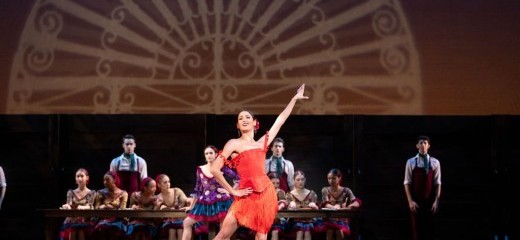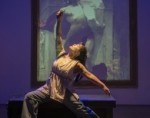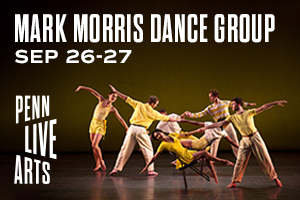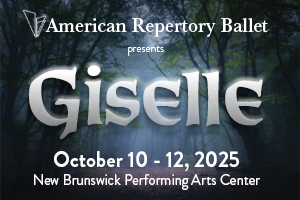
Carmen, Boléro, y La Pasión Española
by Lauren Berlin
Ángel Corella electrified audiences for seventeen years as a principal dancer with American Ballet Theatre in NYC. Now, as Artistic Director of Philadelphia Ballet, he’s doing it again—with Carmen’s defiance, Boléro’s slow-burning tension, and a full company set to ignite the Academy of Music. I caught up with Corella to discuss legacy, risk, and how his Spanish roots continue to fuel his work.
Lauren Berlin: Your Spanish heritage is deeply felt in your choreography and performance. How has your upbringing in Spain shaped your artistic identity—and how does it continue to influence your interpretations of works like Carmen and Boléro?
Ángel Corella: The Spanish ideal of living life to the fullest has always been present for me. In every performance, I gave 200%. That’s how I danced and how I lived. Now, as a choreographer, it comes through in different ways––especially in pieces like Carmen and Boléro. The way Spaniards use gestures and move their hips…Everything is so earthy, so gutsy.
LB: It’s in your spirit. Tu sangre. (Your blood).
ÁC: Exactly. We have a few Spanish dancers in the company, and sometimes they look at me and say, “This is pure Flamenco—we weren’t expecting this.” They think it’s going to be lighter or more stylized, but I go for the pure essence of Spain. Otherwise, it would be another classical ballet with the name Carmen or Boléro.
LB: That intensity, that essence—it really translates onstage. I remember watching you perform Don Quixote with Paloma [Herrera]. When you landed your final jump, the audience was howling. That kind of electricity makes me think of Carmen’s fiery spirit of freedom and defiance. What qualities did you look for when casting your Carmen?
ÁC: Given that this is my twelfth season with the company, I really know our dancers—artistically and technically—which makes casting easier for me. To be honest, almost everyone in the company could do it. I hire dancers who are passionate about the art form, and they follow [artistically and choreographically] wherever you take them. That’s important. But passion is one of the main components for the ideal dancer for Carmen. Carmen lives without regrets. She does what she wants, how she wants. Rather than worrying about the consequences of her decisions, she simply lives. I think people today are more hesitant to live with that kind of fullness—especially because of social media. People are afraid of what others might think of them. But Carmen’s free spirit opens the door to a new wave of feminism. A new perspective on what a woman can be.
LB: So much of that power comes through in the movement itself, which brings me to Boléro. Many say that Boléro doesn’t have a plot. In your version, is there a story unfolding?
ÁC: With Boléro, one of my main goals was to create something to celebrate the 60th anniversary of the company, so I used all 60 of the company’s dancers on stage. I would never compare myself to Balanchine—he was a genius—but like him, I try to make the music visible through movement progressions and the shapes I create. It’s more about the music than any kind of plot.
LB: Ravel’s score escalates with such hypnotic, tension-building force. Its momentum feels almost physical. How do you translate that into dance?
ÁC: It starts small, then builds. The instruments come in slowly as do the dancers. First, there’s a soloist. Then she leaves. Then a duet. A trio. A quartet. Eventually all 60 dancers are on stage. It’s very powerful.
LB: And then there are visual elements like costumes, lighting, spacing.
ÁC: From the beginning, it was clear that the men and women would wear the same costumes to emphasize strength, equality, and unity. I wanted to show that together they share a similar power. Women are strong in different ways than men, but they can still perform the same steps. It’s not about separation—it’s about joining forces: one energy, one movement, one body of dance.
LB: That is beautifully put. It is a powerful image that really resonates.
ÁC: Having the whole company on stage was a rare challenge, but it was such a success that we decided to bring the piece back from last season. When the final note hit (hums the melody), the whole audience stood up. It was incredible. I thought, why not bring both of the Spanish ballets together in one program?
LB: Your impact is felt not only in the work you’ve created, but in the way you’ve carried your energy and identity into ballet from the beginning. When you came to the U.S. in the mid 1990s, you brought a unique intensity and character to ballet. As you look back on your legacy as a dancer and now as Artistic Director of the Philadelphia Ballet, how have you introduced elements of classical Spanish dance into the vocabulary of classical ballet?
ÁC: The beauty of ballet—and what makes it so difficult—is that you have to be open to understanding styles, dynamics, and intention. Every ballet has a completely different energy. Carmen and Boléro, with their Spanish heritage, demand gaudiness, pride, and dancing with your guts. The movement is sharp, and there’s a great deal of upper body expression. You’re doing something incredibly difficult, but you make it look effortless with an aloof pride. Contrast that with the delicacy of Swan Lake—as a dancer, you have to understand these major differences.
When I danced, I brought my Spanish blood, but I also had to adapt when dancing a more elegant role like Romeo, for example. I was lucky to have great coaches who helped me grow. At first, I danced everything with the same energy, but eventually, I learned when to hold back and when to push. That’s what I try to impart to my dancers.
LB: That adaptability and awareness seems particularly crucial when leading a company. Classical audiences often seek the familiar, while younger audiences crave freshness. How do you strike a balance between honoring the canon and keeping the repertoire exciting and forward-thinking?
ÁC: That’s one of the biggest and hardest questions for an Artistic Director. You want to keep longtime patrons engaged, but when full-length ballets are done well, younger audiences also attend. I do a lot of work retouching and modernizing the classical ballet vocabulary, much of which dates back to the 1920s and ’30s. We collaborate often. Our resident choreographer, Juliano Nunes from Brazil, brings a funky, cool movement style—similar to what Kenneth MacMillan did with Manon or Romeo and Juliet. We’ve worked with E.L.O. (Electric Light Orchestra) and are doing more free outdoor performances so people and families who might not connect with ballet in a theater can still engage. Our new building will include a blackbox theater, which will serve as a space for community engagement and education. This will help us reach more people who may not otherwise have access to ballet.
LB: That spirit of accessibility and connection brings me to something more intangible. There’s something indescribable about hearing the musical scores of Carmen and Boléro. The music lifts the dancers into another emotional state. For people who don’t dance—how would you explain that visceral pull? What emotions are you trying to reach?
ÁC: I hope the audience feels like they’re dancing with the dancers. When a performance is magical, it breaks the wall between stage and audience—you feel part of it. People often ask if I miss dancing. I say no, because I feel like I’m dancing with the company on stage every night.
LB: From where you are standing, if you could speak to your younger self—the boy from Spain who would one day direct one of America’s top ballet companies—what would you say?
ÁC: The only thing I’d say to my younger self is: don’t stress so much when things don’t go your way. They will fall into place. If it’s meant to be, it will be. I don’t have regrets. I think I’ve lived the most authentic life I could.
LB: The new Philadelphia Ballet Center for Dance seems like it’s going to be incredible. It feels like a new chapter for the company and the city. When can we expect the opening?
ÁC: The building will officially open in Fall 2026.
Carmen & Boléro, The Philadelphia Ballet, Academy of Music in Philadelphia, Oct 9-12, 2025.
Lauren Berlin in conversation with Ángel Corella, The Ruth and A. Morris Williams, Jr. Artistic Director of Philadelphia Ballet, in-person interview, September 12, 2025.
Homepage Image Description: Company members of the Philadelphia Ballet stand in angular shapes with their arms extending outwards from their chests, with some dancers’ arms on the horizontal plane, and others in 4th position. They wear matching black leotards with a linear design. They perform Bolero, choreography by Angel Corella.
Article Page Image Description: Mayara Pineiro of Philadelphia Ballet performs in Carmen, choreography by Angel Corella. She wears a bright red dress, with one hand affixed to her hip and the other extended outwards on the diagonal plane. A group of dancers sits at the table behind her.
By Lauren Berlin
September 29, 2025










